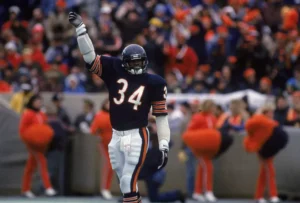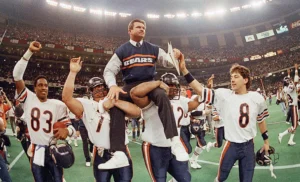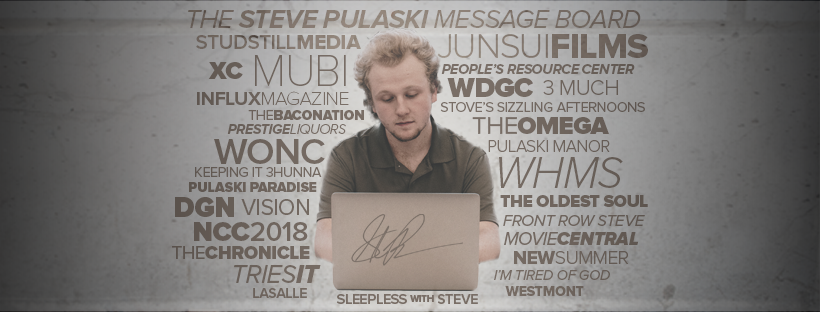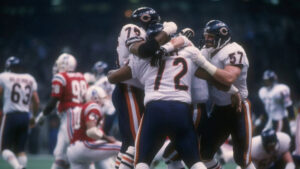30 for 30: The ’85 Bears (2016) review
Dir. Jason Hehir
By: Steve Pulaski
Rating: ★★★½
 Remembering Steve “Mongo” McMichael
Remembering Steve “Mongo” McMichael 
 1957 – 2025
1957 – 2025
I became a Chicago Bears fan during the 2007-08 season, the year following the team’s disappointing loss to the Indianapolis Colts on a rainy Super Bowl Sunday in Miami, Florida. Before then, my grandmother was a lifelong fan and her spirited discussions of the team and its dynamic in the years prior to that all helped me become the Bears fan I am today. I’ll admit that I don’t watch every game, but I’m usually one of the first on Monday morning to read the highlights and entertain myself with Chicago’s prolific coverage of every single Bears game, be it ends in a devastating loss or a triumphant win. I watch as many games as I can and try to stay posted on the team’s news, but anyone who is a Bears fan in the present day knows how discouraging it is and how many times we say, “we’ll get ’em next year” only for next year to result in similar disappointment.
This is a pretty obvious way to say that my bias for this franchise may sneak in just a tad during this review. However, if the latest installment in ESPN’s amazing “30 for 30” documentary series, this one called The ’85 Bears, honoring one of football’s most charismatic teams in history, does anything wrong, it’s remind us what a lackluster team we, Bears fans, currently have. It’s a team that lacks identity, focus, and for that matter, on-field talent to match the driven and experienced coaching staff. But watching The ’85 Bears, one of the last emotions you should feel is disappointment; this is a documentary that beautifully articulates the team’s unfathomable accomplishments and universal talent that made them national superstars. The 1985 Chicago Bears team is an underdog story fit for a movie I’d probably review and write off as implausible and far-fetched.

But alas, the 15-1 team that, four years prior, was a laughable, disorganized mess of a team with an elite defense that had the gall to pen a letter to team owner George Halas that the entire coaching staff, with exception of defensive coordinator Buddy Ryan, needed to be fired managed to defy all odds. Director Jason Hehir chooses to craft the thesis for his documentary on Ryan, somebody you wouldn’t initially think would be at the center of a Bears documentary. It actually spends so much time humanizing Ryan and his process that it neglects to show what Ditka really did to transform a losing team into an unstoppable football force. New generation Bears fans like myself rave about Mike Ditka (with reservations), Jim McMahon, William “Fridge” Perry, and Steve McMichael to no end, but often forget about the legendary impact of Ryan, who, through militaristic drills and incalculable persistence, crafted a defense that could probably have stopped a bulldozer from plowing down the field.
Following miserable seasons in 1980 and 1981 that showed a lack of discipline on behalf of the coaching staff, former Chicago Bears player Mike Ditka was brought in as head coach in 1982 and promised the disillusioned Bears a Super Bowl win in only three years. The problem was, as he stated, was that only half of the team would be around to see it. Both Ditka and Ryan, two souls who rarely intersected or challenged one another on the field, coached the team into a slew of boisterous, arrogant football players that thrived because of their unique personalities and revolutionary talents. You had the aforementioned Perry, nicknamed “Fridge” because of his 300-pound stature that would pummel any opponent to the ground, Walter Payton, the team’s star running back who, prior to the organization Ditka pushed for, was getting terribly beat up on the offensive line, Kevin Butler, the team’s charismatic kicker, Mike Singletary, the team’s determined running back who formed a sacred bond with Ryan, and Gary Fencik, the level-headed safety, just to name a few of the impacting members of an elite team.
Finally, there was quarterback Jim McMahon, an unlikely, loose-canon Catholic kid from Brigham Young University, who frequently disobeyed Ditka’s play-calling to carry out his own personal judgments. Most of the time they were successful, but that didn’t stop Ditka from getting red in the face spitting and hollering at McMahon and the team around him for going along with the play. McMahon was also not a big fan of practices or things leading up to the big game. “I didn’t like practice,” McMahon states in the film, “I didn’t like meetings. I liked Sundays.” Together, all these guys merited domestic stardom, boasting endorsements and much more as the country’s most wanted commodity.

The ’85 Bears works to show how this team was built together from the perspectives of the players and illustrating the bonds between the players without having them cross paths in the present time. The only time members of the original ’85 Bears rekindle at any time in the film is when Mike Singletary pays a visit to Buddy Ryan, who, in the present day as we see, can’t walk, can barely talk, and uses a variety of exercise machines in order to recover from various strokes and health problems. Ryan, who was never one to show emotion on or off the field, clearly is humbled and honored to be in the presence of Singletary when he pays him a visit, and just three decades prior, the roles were reversed. If nothing else, this documentary works to humanize the bond that football brings to its players and it beautifully details that with these heartfelt sequences.
One of the most noticeable things about the ’85 Bears is how violent and unabashedly relentless they were as football players. This was a group of guys that would probably all be on probation or some kind of suspension if they played like that in the modern day, or at least be fined their entire year’s salary. It wasn’t uncommon for the team to take out two or three quarterbacks a game with their hard hits and their relentless blows. This was what helped make them who they were.

Hehir doesn’t work to obscure the real sadness that plagued the team following their 46-10 Super Bowl XX victory over the New England Patriots which, at the time, was the largest point-spread in Super Bowl history. A few days after the team’s victory, the Challenger exploded shortly after takeoff, shutting up all news coverage that didn’t have to deal with the tragedy. Following that, the Bears never returned to the Super Bowl, and the team wound up aging and retiring as time went on: McMahon went on to be traded to many different teams, Payton was stricken with a rare liver disease and died less than a year after diagnosis, Ryan went on to be the head coach of the Philadelphia Eagles, and soon, the ’85 Bears dissipated into an entirely new, less-than-impressive team.
Today, the Bears haven’t been to the playoffs since their 2010 season, and have been through three head coaches in the last four seasons. Upon two miserable seasons with former-Canadian Football League coach Marc Trestman as head coach, they now have John Fox as their leader, one of the few coaches in franchise history to hold the job and possess prior NFL head coaching experience. The Bears have always been a team to do things differently, but as of late, they’ve been plagued by poor circumstance, poor play-calling, questionable front office moves, unfair or outlandish signings and contracts, and much more. The ’85 Bears are now thirty years into the history books, but Hehir’s terrific documentary encapsulates their hard-hitting impact as a team and their unforgettable legacy that often places them at the top of lists of the greatest NFL teams.
My review of ’85: The Greatest Team in Football History (2018)
Directed by: Jason Hehir.
About Steve Pulaski
Steve Pulaski has been reviewing movies since 2009 for a barrage of different outlets. He graduated North Central College in 2018 and currently works as an on-air radio personality. He also hosts a weekly movie podcast called "Sleepless with Steve," dedicated to film and the film industry, on his YouTube channel. In addition to writing, he's a die-hard Chicago Bears fan and has two cats, appropriately named Siskel and Ebert!


